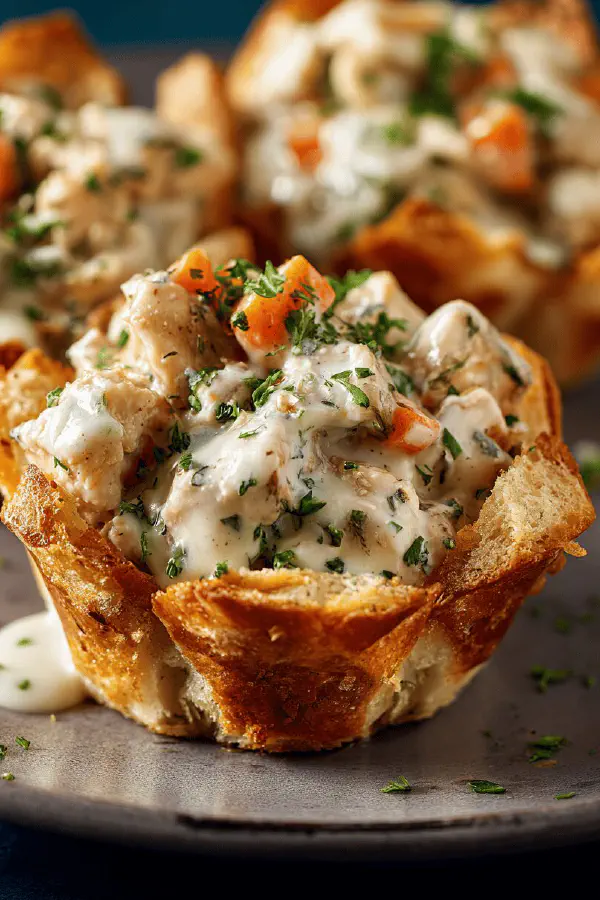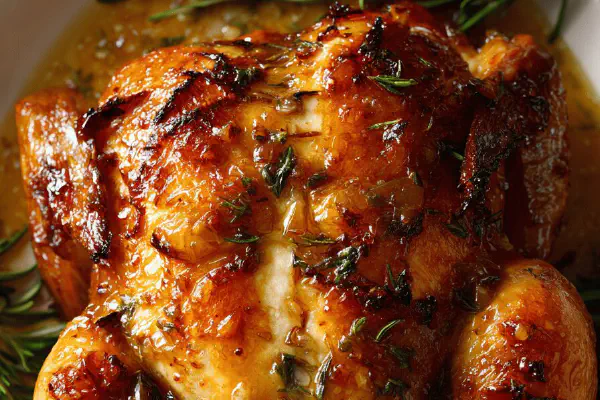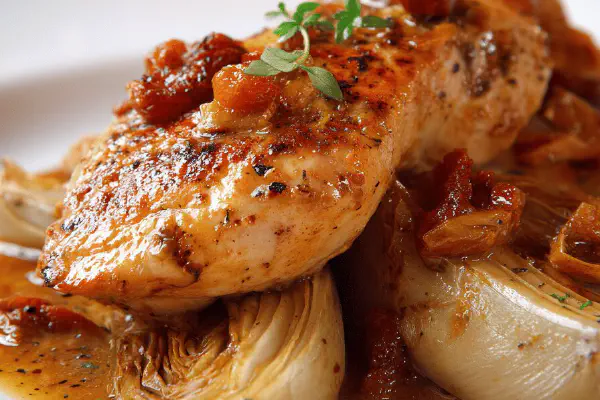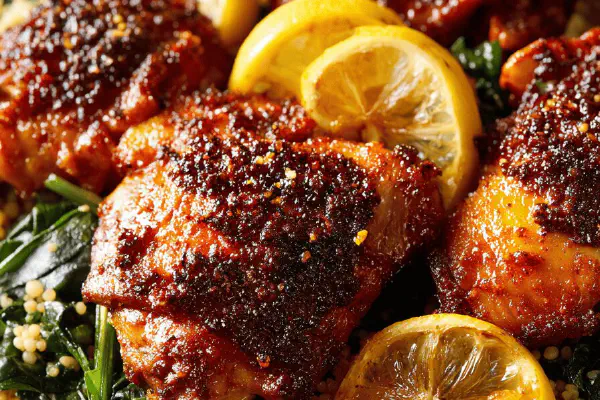Featured Recipe
Homemade Chicken Vol-au-Vent

By Kate
"
A practical, hands-on method to make chicken vol-au-vent using bread-lined muffin molds. Buttered bread crisps up golden in the oven forming crusty cups, a quick fix instead of puff pastry. The creamy filling gets a twist by swapping béchamel’s milk for light cream and swapping peas for diced carrots for a subtle sweetness. Chicken diced, simmered into the sauce until thickened and bubbling. Crisp texture with tender filling. Technique-focused, timing adjusted for real kitchens.
"
Prep:
12 min
Cook:
28 min
Total:
40 min
Serves:
4 servings
chicken
easy cooking
French cuisine
Introduction
Bread shells instead of puff pastry. Why wait for dough to rise or thaw? Quick butter layer crisps bread into shape, sturdy enough for creamy filling. Chicken diced sharpens texture, carrots sneak in moisture and slight sweetness. Cream sauce replaces classic béchamel milk for smooth mouthfeel. Timing key—bread going golden hints readiness; listen for hollow sound when tapped. Filling thickened just right, coats spoon, clings but not gluey. Natural seasoning calls for white pepper, barely a pinch of nutmeg — subtle but builds layers. Assemble just before serving; soggy sight ruins crisp contrast. Test edges before unmolding, handle gentle with still-warm shells. No fluff, straight to method that saves time and mess. Get grounded in real kitchens where efficiency meets flavor.
Ingredients
About the ingredients
Bread choice alters crust texture. Use firm, unsliced sandwich bread or a hearth loaf sliced evenly. Stale bread works nicely too—absorbs butter without sogginess. Butter amount precise—too much means greasy pockets and burnt pan tips; too little, dry shells. Cream makes sauce velvety; milk can substitute but watch for thickness, cook slower. Carrots bring natural sweetness and bright color, green peas swap in but add at different time since peas soften faster. Chicken best cooked beforehand—boiled, roasted, or leftover; keeps consistent texture and shreds/clumps avoided. Salt and white pepper preferred to black for color and smoothness; nutmeg a classic but optional. Prep sauces on gentle heat, whisk continuously to avoid lumps. Bread shells require even pressing into cups for uniform rise and crisping. Takes practice but worth the tactile feedback.
Method
Vol-au-vent shells
- Position oven rack mid-level. Preheat to 175 °C (350 °F).
- Spread butter thinly one side of each bread slice. Press buttered side down firmly into muffin tin cups; make sure edges are snug to form walls.
- Bake shells 18 to 22 minutes. Look for deep golden-brown color and crisp edges. Tap top—should sound hollow and hold shape when lifted. Remove, cool slightly, unmold carefully to avoid cracks. Set aside.
- Prepare cream sauce substituting milk with light cream for richer mouthfeel. Cook gently to avoid curdling, whisk constantly.
- Add diced chicken and carrots directly into the sauce. Simmer about 4 to 5 minutes until carrots soften but retain slight bite. Stir often; sauce should thicken enough to coat spoon generously. Season with salt, white pepper, and a pinch of nutmeg. Taste test crucial here.
- Spoon generous amounts of filling into each bread shell, let some spill slightly over edges. The heat will soften the bread edges softly but maintain crispness underneath.
- Serve immediately for best texture. If preparing ahead, keep shells separate and warm sauce conveniently. Avoid sogginess by assembling last minute.
- Bread shell shortcut replaces flaky pastry—faster but less buttery. Use brioche for extra richness or whole wheat for texture contrast.
- Carrots add natural sweetness and color; green peas exchangable but adjust timing to soften properly.
- If cream is unavailable, milk plus a small pat of butter works; just watch sauce thickness carefully.
- Chicken leftovers perfectly suited here; if raw, poach gently seasoned with bay and peppercorns to keep moist.
- Watch oven closely near end; bread can go from gold to burnt quickly. Avoid overbuttering – too much seeps out creating sogginess and smoke.
- No broiler needed but can crisp edges briefly at end for extra bite—watch carefully.
- Troubleshoot pale, floppy shells: push bread deeper and press edges firmly into pan, use slightly thicker bread slices.
Filling
Assembly
Tips and substitutions
Technique Tips
Press buttered bread firmly into muffin cups until sides straighten and form bowls. If air gaps remain, edges collapse during bake. Oven temperature critical—too high means burnt edges before inside crisp; too low will dry without crisp. Listen for crisp crackle on cooling. When ready to fill, sauce must be thick enough to coat but pourable. Simmer chicken and carrots in sauce gently; rapid boiling breaks chicken fibers, toughens. Stirring prevents sauce sticking and burning on pan bottom. Taste filling before spooning in shells; adjust salt/pepper/nutmeg carefully—sauce dull when cold, needs punch. Assemble last minute, else crisp shells absorb moisture; if prepping ahead, keep shells in cool dry place, reheat filling separately then combine. If shells get soggy, reheat in oven briefly to regain texture. Serving hot keeps contrasts clear between crunchy shell and creamy inside. Plates must be prep-ready; these cool fast and lose texture quickly.
Chef's Notes
- 💡 Bread choice influences texture; use sturdy sandwich bread. Crusts off for even baking. Brioche adds richness, whole wheat for texture.
- 💡 Butter amount matters; if too much, soggy bread. Too little, dry and brittle. Aim for thin, even coverage. Check edges; should hold shape.
- 💡 Carrots bring sweetness, color. Add fresh or frozen, adjust cooking time. Diced smaller cooks quicker. Avoid mushy by tasting regularly.
- 💡 Thickness of sauce crucial; should coat spoon. If too thin, simmer longer. If too thick, thin with water or low-sodium broth.
- 💡 For leftovers, chicken works great. Poach with herbs or stock for added flavor. Dry chicken? Toss in sauce as you heat. Not much prep needed.
Kitchen Wisdom
Can I substitute chicken?
Sure, turkey or even mushrooms work. Cook time may need adjusting. Using leftovers saves time and effort.
How do I avoid soggy bread shells?
Assemble just before serving. Keep shells and filling separate if prepping ahead.
What's the best way to reheat?
Oven works best; crisp edges regained. Microwave makes them soft. Short time on low heat.
Can I use a different sauce?
Yes, any creamy base works. Try using a cheese sauce or even Alfredo. Just watch thickness.



